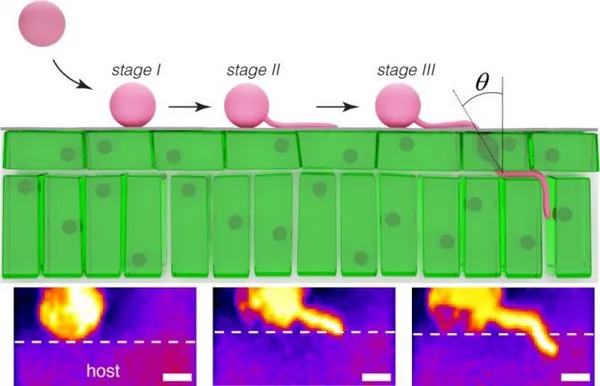In the 19th century, the notorious pathogen Phytophthora infestans caused a large famine in Ireland and other parts of Western Europe. To this day, it continues to pose a major threat to global food production. It has long been a mystery how this microscopically small organism and other members of the Phytophthora genus mechanically gain entry through the protective layer on the leaves of crops. In a unique collaboration, Wageningen University & Research experts in plant pathology, cell biology and physics have now found an answer to this question. Their discovery also provides new leads to making the control of Phytophthora more effective, more efficient and more sustainable on the long term. Their findings are published in Nature Microbiology.
Plants are under constant threat from all kinds of pathogens. A number of these intruders bearing the difficult name Phytophthora (literally: plant destroyer), cause enormous damage yearly to all kinds of crops, such as potatoes, tomatoes, eggplant, cocoa, peppers, soy and date palm, as well as to woodlands and nature reserves. Phytophthora not only poses a major threat to our food security, but also results in vast economic damages, causing annual damage to the potato sector of approximately 6-7 billion euros.
Combatting Phytophthora is and remains problematic, in part because the pathogen and its target are engaged in an ongoing arms race. Tremendous resources are invested in the development of resistant crops through plant breeding, with the aim of becoming less dependent on chemical crop protection. There is also increasing interest in new forms of mixed cropping.

Infographic that illustrates how Phytophthora gains access to a plant/ Image: WUR
Utilising Insights from Mechanics
Another option has now arisen; preventing Phytophthora from gaining access to a plant altogether. Plants come equipped with a protective layer that serves to keep intruders like Phytophthora out. Yet, this microscopically small pathogen (smaller than one tenth of the thickness of a human hair) is able to penetrate this layer and initiate its disease process in plants. Despite decades of research, it remained unknown how they mechanically penetrate this layer. To solve this problem, WUR plant pathologists and cellular biologists joined forces with WUR physicists. The latter are specialists in mechanics, a branch of physics that studies how objects and materials move and respond under the action of forces acting upon them. Their combined knowledge, and new research tools developed in collaboration, could finally bring resolution to this puzzle.
Sharp Knife
“We discovered that Phytophthora uses clever tricks to sharpen its tubular infection structure to then cut through the surface of the plant with a sharp knife. Using this strategy, Phytophthora is able to infect its host, without brute force and with minimal consumption of energy. This is the first time that this mechanism has been uncovered, and really a fundamental discovery,” Joris Sprakel, professor in Physical Chemistry and Soft Matter, says.
For more information: wur.nl
